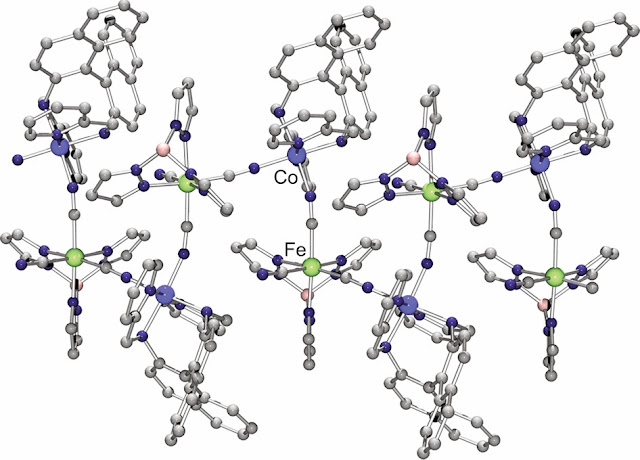Any idea what that is? Well I can tell you this much, it's a rather complex chain of carbon molecules thrown together in a seemingly random format that creates something just as complex as the subatomic structure in front of you now. Now you may be asking yourself, "ok...if he doesn't know what this is then why do I care?" It's just an example. I wanted to show you how truly AWESOME Carbon is before I proceeded because this entry is going to be a doozy.
The structure above you as I said is unimportant, the green atoms are FE (Iron) ions and the purple is N (Nitrogen) but these are superfluous for the purposes of this. The really cool one, the one that is hands down my favorite little guy on the periodic table are the little grey spheres. Those are C (Carbon) and boy there sure are a lot of them. That's because Carbon is the most versatile of our known elements. It's capable of bonding with virtually anything (Like a drunk creep at a local pub) and not only that but allowing other elements to bond together that normally wouldn't coincide by creating a buffer zone so to speak between the two. It's the essential ingredient in our DNA, (the building block of human life) and is found in all our sugars, proteins, fats, etc. In fact, the only thing in our bodies where Carbon is NOT present, is in water. (That of course is H2O)
Without Carbon, life as we know it couldn't exist. That's why for the past few decades in our search for life elsewhere in the galaxy we have been searching for "Earth-Like" planets located within a so-called "habitable zone". Factors like distance from their sun, surface temperature, presence of water, atomspheric conditions, so on and so forth comprise the list of tell tale signs of life. But what if life out there isn't Carbon based? We've never encountered anything non-Carbon based on our planet, so how would we begin to test for that? Hmmm, well, let's analyze that last statement because while Carbon is found in virtually EVERYTHING it doesn't always have to be the omnipresent substance within the organism.
In 2008 Stephen Hawking, a well respected physicist and mathematician was asked at the 50th year celebration of NASA if we were alone in the universe. Instead of telling everyone at the conference yes we are or no that's absurd, he simply said "probably not." During the course of it he proposed many different possibilities for other elements that may be potential building blocks for other sentient forms of life elsewhere. These included, but were not limited to, arsenic, silicon, and even phosphorous! That's pretty incredible to think about considering how deadly arsenic is to us! You can read more about the Stephen Hawking lecture here at The Daily Galaxy.
That may sound TOTALLY insane to you right? An arsenic or a silicon based life-form? Well, many scientists would agree with you, but there are an astoundingly growing number of those who wouldn't. Dr. Tom Gold of Cornell University would be one such of those people. In agreement with Hawking to an extent he has written an entire book about Silicon based life-forms. His proposal though? We don't even have to go into space to find them. He believes we have intraterrestrial life right here in the crust of our planet! If that's not enough, he speculates that the fossil fuels weren't caused by breakdown of of Carbon based life but may in fact be something our planet needed in order to get its creation going! Yikes! Lots of theories, the book is called The Deep Hot Biosphere, and you can find more information on his exciting thoughts in an article found at that link.
So Phosphorous and Arsenic? Yep. Phosphorous, similar to Carbon in that it can also form complex chains thereby changing the potential for eventual structure, given the right conditions could produce an intelligent life-form. (can't be worse than a politician, am I right ;]) And when water is mixed with ammonia it can keep at much colder temperatures. We've recently found life (in the past five years recent!) in what was once thought to be uninhabitable depths in the oceans. We've discovered algae that thrives by converting Arsenic into essential proteins in order to survive. In short, if life on Earth here is so much weirder than we thought, what's to stop life out there from being any weirder?
Now I think you're starting to see why scientists are going back and rethinking what was once thought to be the all encompassing habitable zone. It was naive and narcissistic at best for humans to use our way of life as the sole basis for life elsewhere in the world. Let's hope the new scanning and testing equipment launched in upcoming years brings back information of aliens existing out there, be it super intelligent beings or microbial bacteria. It would also be really neat to discover an alien race comprised of silicon like we are of Carbon.
If that were the case, they may think a few of our celebrities are long lost members of their strange alien race. ;)



No comments:
Post a Comment